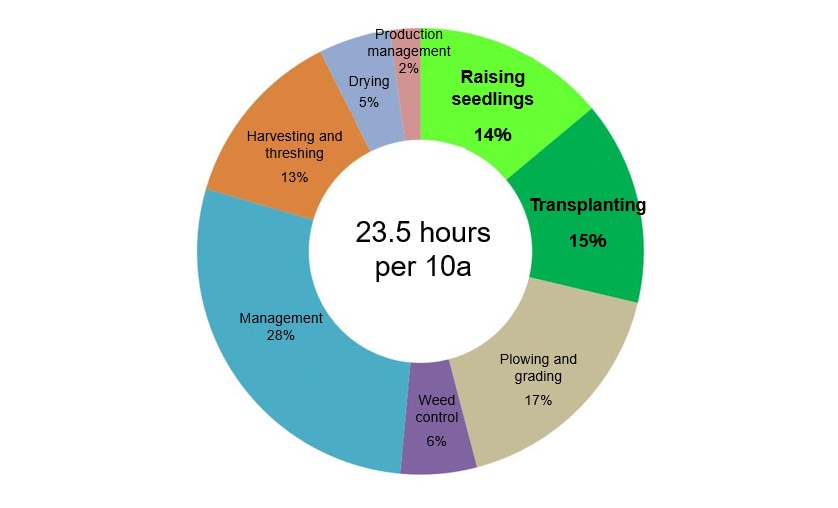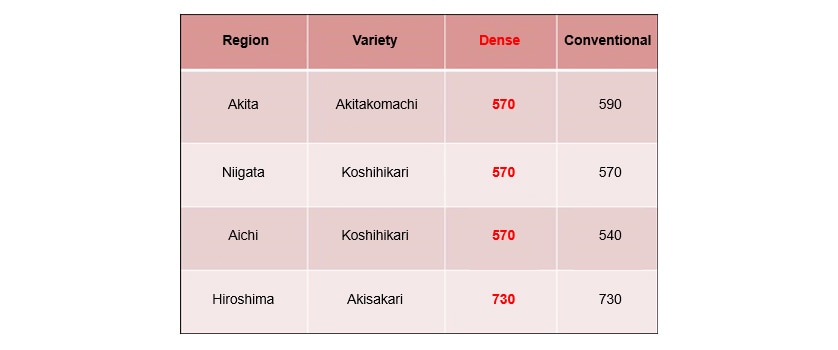Development Division
YANMAR AGRIBUSINESS CO., LTD
YANMAR Technical Review
Innovative Low-Cost, Labor-Saving Technology for Rice Transplanters Using Dense Seedling and Automatic Adjustment of Planting Depth
Abstract
Dense seedling is a technique for sowing and raising seedlings at high density and with high accuracy. Whereas conventional practice is to sow 100g to 200g of seeds in each tray, dense seedling sows 200g to 300g in each tray. Transplanting such dense seedlings requires precise picking using a special tine mechanism together with an automatic system for adjusting the planting depth. This technology increases revenue by significantly reducing the number of seedling mats required, lowering material costs, saving labor, and increasing the efficiency of rice production. It was recognized in the "Newest Agricultural Technology/Variety 2016" published by the Ministry of Agriculture, Forestry and Fisheries.
1. Introduction
As Japan has been making a shift to greater scale in paddy-rice cultivation over recent years, the raising and transplanting of seedlings has emerged as an obstacle to this process. At 25 to 30%, these works make up the largest part of the labor costs for paddy-rice cultivation. This trend becomes more pronounced the greater the scale of the farming operation (see Fig. 1). Also, about 30% of direct working hours are spent on the raising and transplanting of seedlings. These works have become an important problem to be solved for expanding scale (see Fig. 2).
While practices adopted in response to this problem have included direct sowing or widely spaced transplanting, concerns such as yield stability mean that these account for only a small proportion of the total area under paddy-rice cultivation. This technical report describes a technique for dense seedling transplanting that is aimed at reducing labor requirements while at the same time achieving yields not less than conventional transplanting with equivalent management practices.


2. What is Dense Seedling Transplanting?
Dense seedling transplanting is a technology of reducing the number of seedling mats needed per unit area by equipping the rice transplanter with the precise operation to pick seedlings from the mat sowed at high density. Conventional seedling practice is to sow100 to 150g (dry paddy weight) of seed paddy per mat, whereas dense seedling practice is to seed 200g to 300g. Having been sowed and raised at this high density, the rice transplanter requires a high level of precision to pick up three to five seedlings per hill (see Fig. 3). This means that a large number of seedlings can be pickedfrom each seedling mat, therefore the number of seedling mats used can be reduced to between one half and one third. This cuts material costs and saves labor by reducing the amount of work needed for raising, transporting, and supplying the seedlings.
Yanmar developed this dense seedling transplanting technique thorough integrating cultivation techniques using dense sowing together with raising seedlings and transplanting techniques able to plant the seedling with high precision.

3. Cultivation Techniques
Cultivation practices for dense seedling are much the same as for conventional seedling. These are described below.
- (1)Seed preparation (seed disinfection, soaking, and forced sprouting) is the same as conventional practices.
- (2)The time from sowing until the optimal time for transplanting is two to three weeks for dense seedling. This compares to three to four weeks for conventional seedling.
- (3)Because of the need to achieve seedling height more quickly, greater care is needed in the raising of seedlings in the seedling house than is the case with conventional seedling so as to prevent the interior temperature getting too low. Moreover, because the higher density of seedlings makes for higher levels of transpiration, care is needed to ensure adequate watering.
- (4)The size of the seedlings at the time of transplantation may be somewhat smaller than that of the conventional seedling. Whereas conventional seedling typically have a foliar age of 2 to 4 and a plant height of 10 to 25cm, those from dense seedling have a foliar age of 2 to 2.3 and a plant height of 10 to 15cm.
- (5)As the transplanted hills are smaller and lighter than for conventional seedling, transplanting into deep water or rapid irrigation inflow needs to be avoided to prevent floating seedlings.
- (6)The heading and maturity times are one to three days delayed compared to conventional seedlings transplanted on the same day.
As this demonstrates, apart from the shorter time taken to raise the seedlings, there is little difference between dense and conventional seedling. It can be anticipated that the shorter time for raising seedlings will increase productivity by spreading the work of sowing and transplanting.
4. Transplanting Techniques
Dense seedling transplanting has the following characteristics due to the very small size of each picking
- (1)The small size of the hills makes them prone to floating or lodging.
- (2)The small size of the hills means that precise picking operation is required.
The following describes a rice transplanter developed to deal with these technical problems.
4.1. Automatic Adjustment of Planting Depth
As the hills for dense seedling are light and contain less seedbed soil, being only one-half to one-third the size of those for conventional seedling, they are prone to misplanting (floating or lodging seedlings). As a result, an operator using a current rice transplanter for dense seedling transplanting needs to make fine adjustments depending on the condition of the paddy field, a task that is made challenging by the difficulty of making adjustments and the annoyance of machine operation. To overcome this, Yanmar developed the rice transplanter with a function for automatically adjusting the planting depth. The following section describes in detail how this works.
On conventional rice transplanters, a float located under the central part of the planting portion at the rear of the machine detects unevenness in the surface of the paddy field. As the angle of the float varies depending on the height of these undulations, the height of the planting portion is controlled so as to follow the surface of the paddy field, being raised or lowered so as to keep this angle constant. However, for the same float angle, the position of the float relative to the ground level can be different depending on the field conditions (such as soil hardness or presence or absence of water), causing the height of the planting portion relative to the ground level to fluctuate. As a result, the seedling planting depth would fluctuate (see Fig. 4). This requires the operator to visually check the track by the float left in the paddy field and adjust the target float angle so as to maintain a constant planting depth. This is difficult for even an experienced operator to adjust. As dense seedling has a greater risk of floating or lodging, it requires that even greater attention to be paid to this adjustment than is the case for conventional planting. The result is likely to be a higher workload imposed on the operator.
In response, Yanmar has developed and adopted automatically adjusting the planting depth that works by adjusting the target float angle based on the condition of the paddy field. To make this function possible, a rake sensor was added near the float to detect the paddy field level. By doing so, the rake sensor can detect the level of the float relative to the paddy field, and this information is then used to control the target angle for the float automatically (see Fig. 5). This enables a reliable planting depth to be achieved without the operator having to make continual adjustments depending on the condition of the paddy field.


4.2. Planting Arm and Feed Mechanism
Reducing the number of seedling mats requires the ability to plant three to five seedlings per hill and to pick off these hills accurately and with small size. However, when conventional transplanting tines are used for dense seedling transplanting, the risk of damaging seedlings due to the poor balance between the amount being picked and the tine width is concerned. Design for improvement was needed. This was done by making the width of both the tines that pick off the seedlings and the mating part forks narrower than that of conventional rice transplanters so as to fit the needs of dense seedling transplanting .(see Fig. 6).
To compliment the narrower tine width, the seedling feed amount was also reduced. The feed amount being longer regarding the tine width means that more seedlings are contained in each hill. Accordingly, a small feed amount level was added to suit dense seedling.

5. Verification of Effects of Dense Seedling
5.1. Reduction in Material Cost and Labor Requirement
A reduction in material costs and labor requirement to between one-half and one-third previous levels can be expected (see Fig. 7).
The results of testing to grasp the actual usage of seedling mats is also shown for reference. This found that a reduction had been achieved, with a mean of 7.6 mats being used, and with eight or fewer mats being used on 80% of occasions (see Fig. 8).


5.2. Equivalent Yield to Conventional Practices
The results of testing at paddy fields belonging to 342 different farming operations from around Japan, covering 242ha and 51 paddy rice varieties, indicated that the yield is equivalent to that of conventional practices (see Table 1).
Table 1 Yields for Dense Seedling and Conventional Seedling (Excerpt)
(Based on In-House Research by Yanmar)

6. Conclusions
The following results were confirmed for the development of technology for dense seedling transplanting that combines cultivation techniques for sowing and raising seedlings at high density and techniques for precise transplanting.
- (1)The number of seedling mats used can be reduced to between one-half and one-third previous levels, and material costs and labor requirements can also be reduced.
- (2)The same management practices as conventional transplanting can be available.
- (3)The same yield as conventional transplanting can be achieved.
The technology was recognized in the "Newest Agricultural Technology/Variety 2016" published by the Ministry of Agriculture, Forestry and Fisheries in 2016, and has been adopted nationwide. The YRD series of rice transplanters that incorporate this technology were launched in 2016 and were found in a market survey of users and distributors to be well evaluated not just for dense seedling but also for their ease-of-operation.
In the future, Yanmar intends to continue helping Japanese and foreign agricultural producers to achieve stable and higher revenues through the development of technologies that enhance lifecycle value (LCV) by reducing the lifecycle costs (LCC) that influence agricultural producer’s profitability.
-IMPORTANT-
The original technical report is written in Japanese.
This document was translated by Research & Development Management Division.
Author
